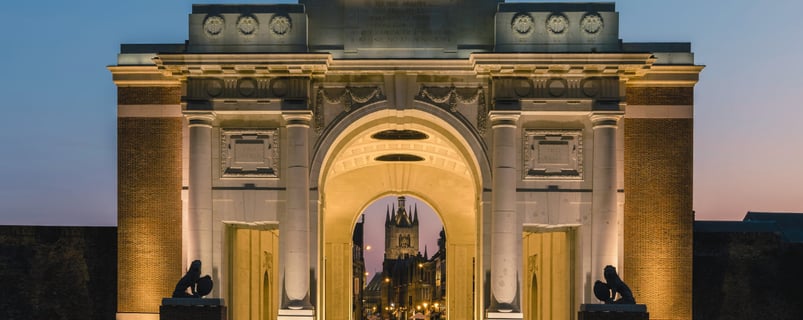Belgium's Role in World War I: A Journey Through Ypres and Its Historical Sites
Discover Belgium's significant role in World War I with a visit to Ypres. Explore preserved trenches, cemeteries, and attend the Last Post ceremony at Menin Gate for an unforgettable historical journey.
Catherine Choco
11/26/2024
Belgium holds a significant place in the history of World War I, particularly in the city of Ypres and its surrounding areas. For those interested in understanding the impact of the Great War, Belgium offers an immersive journey into the past that is both profoundly moving and intellectually enriching. Ypres, also known as Ieper, became the focal point of some of the bloodiest and most strategically important battles of the conflict. The city and its surrounding battlefields provide a poignant and comprehensive view of the immense sacrifices made during the war.
Discover Belgium's Role in World War I
Ypres, once reduced to rubble, now stands as a testament to human resilience. Situated in West Flanders, the city was the epicenter of some of the most intense battles of World War I, including the First, Second, and Third Battles of Ypres. The strategic importance of Ypres drew the attention of both Allied and Central Powers, leading to repeated attempts to control the area. Today, Ypres has been meticulously rebuilt, yet the scars of war remain preserved in its historical landmarks, serving as vivid reminders of the sacrifices made. The marks left by artillery shells can still be seen on certain buildings and in the surrounding landscape, acting as silent witnesses to the brutality of the conflict.
One of the most poignant experiences in Ypres is visiting the Menin Gate. Here, the Last Post ceremony takes place every evening at 8 PM, honoring the fallen soldiers of the British Commonwealth whose names are inscribed on the gate. The solemn call of the bugles is a profound and humbling experience, paying tribute to those who made the ultimate sacrifice. This enduring tradition, maintained since 1928, underscores the lasting gratitude owed to those who fought for freedom. The gate itself bears the names of over 54,000 soldiers who died in the Ypres Salient and have no known grave, serving as a powerful reminder of the human cost of war.
To gain a deeper understanding of the realities faced during the war, a visit to the In Flanders Fields Museum is essential. Housed in the Cloth Hall of Ypres, the museum offers an immersive experience that combines personal stories, authentic artifacts, and interactive displays. These elements vividly convey the hardships and resilience of individuals who endured the Great War, providing invaluable insights into the human dimension of the conflict. The museum's multimedia exhibits allow visitors to engage with firsthand accounts from soldiers and civilians, offering a nuanced perspective on the war's impact on daily life. The striking displays and poignant storytelling create an atmosphere that evokes a deep empathy for those who lived through these harrowing times.
Step into History: Preserved Trenches and Cemeteries
No exploration of the Ypres region is complete without visiting the preserved trenches at Hill 62. Walking through these trenches allows visitors to almost tangibly feel the echoes of the past — the tension, the courage, and the fear experienced by the soldiers. It offers a unique opportunity to witness firsthand the conditions of the front lines and understand the immense challenges faced by those who served. The trenches, still muddy and confined, provide an authentic glimpse into the harsh realities of trench warfare, where soldiers spent weeks or months enduring relentless artillery bombardments, harsh weather conditions, and the constant threat of enemy attacks.
Another critical site is the Tyne Cot Cemetery, the largest Commonwealth War Graves cemetery in the world. Located near Passchendaele, Tyne Cot is the final resting place for nearly 12,000 servicemen, with an imposing memorial wall bearing the names of over 34,000 soldiers who have no known grave. Standing amidst the countless rows of white headstones, one cannot help but reflect on the vast scale of the sacrifice that marked World War I. The cemetery's serene atmosphere, juxtaposed with the overwhelming number of graves, underscores the enormity of the loss. The visitors' center at Tyne Cot also provides additional context, offering detailed information about the battles that took place in the area and the soldiers who fought in them.
Another significant site to visit is the Langemark German Cemetery, which provides an important counterpoint to the Commonwealth cemeteries. The somber atmosphere here, with its dark stone markers and mass graves, serves as a reminder that the tragedy of war affected both sides. Unlike the Commonwealth cemeteries, Langemark has a much more understated and stark design, evoking the somber nature of the losses endured by the German forces. Visiting both Tyne Cot and Langemark offers a more balanced perspective on the war, highlighting the shared human suffering experienced by all sides involved in the conflict.
Why Visit Ypres: Honoring the Past, Embracing Peace
Belgium's role in World War I is a narrative of extraordinary courage, sacrifice, and perseverance. A visit to Ypres and its surroundings is not merely an exercise in historical education; it is an opportunity to connect deeply with the past and appreciate the profound cost of the peace we enjoy today. These memorials and museums serve as powerful reminders of history's lessons, urging us to honor those who fell and to commit to a future that avoids such devastating conflicts. The experiences offered in Ypres are a stark reminder of the consequences of war, instilling a sense of responsibility to ensure that such tragedies are never repeated. By understanding the history and reflecting on the sacrifices made, visitors can leave Ypres with a renewed commitment to peace and international cooperation.
Plan Your Journey to Ypres
Whether you are a history student, an academic researcher, or simply a traveler seeking a meaningful experience, Ypres offers an enduring impact. The historical sites, narratives of heroism, and the lasting message of peace make Ypres a destination that should be experienced at least once by anyone with an interest in history and humanity. To make the most of your journey, consider planning a visit around one of the major anniversaries of the battles, when the city often hosts commemorative events and reenactments. These events provide a unique opportunity to engage more deeply with the history of the Great War and witness the community's ongoing dedication to honoring the memory of those who fought.
In addition to the well-known sites, Ypres also has several lesser-known but equally moving locations, such as Essex Farm Cemetery, where John McCrae wrote his famous poem "In Flanders Fields." The cemetery and the preserved bunkers nearby provide further insights into the experiences of the soldiers who served on the front lines. There is also Sanctuary Wood, another preserved trench site that offers a more raw and less manicured glimpse into the chaotic and often desperate conditions of trench warfare. Visiting these sites adds layers to the understanding of the broader conflict, offering a more comprehensive view of the war's many facets.
Have You Experienced Ypres?
Have you visited Ypres or any of the World War I historical sites in Belgium? I invite you to share your reflections or experiences in the comments below. Together, we can honor the memory and ensure that the lessons of the past continue to resonate. Sharing these experiences not only helps to keep history alive but also fosters a collective commitment to understanding the past in order to build a more peaceful future. Whether you have visited the major memorials or discovered hidden gems, your insights can help others appreciate the profound significance of Belgium's World War I heritage.


